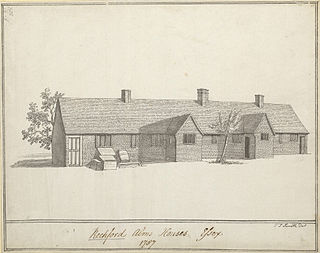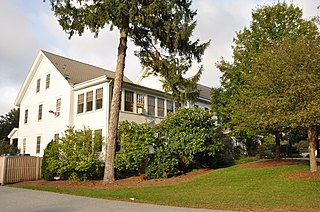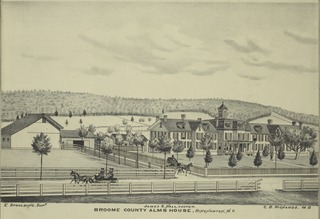
An almshouse is charitable housing provided to people in a particular community. They are often targeted at the poor of a locality, at those from certain forms of previous employment, or their widows, and at elderly people who can no longer pay rent, and are generally maintained by a charity or the trustees of a bequest. Almshouses were originally formed as extensions of the church system and were later adapted by local officials and authorities.

A poorhouse or workhouse is a government-run facility to support and provide housing for the dependent or needy.

Harrisburg State Hospital, formerly known as Pennsylvania State Lunatic Hospital from 1851 to 1937, in Harrisburg, Pennsylvania, Dauphin County, on Cameron and Maclay Streets, was Pennsylvania's first public facility to house the mentally ill and disabled.

The Blockley Almshouse, later known as Philadelphia General Hospital, was a charity hospital and poorhouse located in West Philadelphia. It originally opened in 1732/33 in a different part of the city as the Philadelphia Almshouse. Philadelphia General Hospital closed in 1977.
Oak Forest Hospital of Cook County is a 600+ bed hospital located in south suburban Oak Forest, Illinois. It specializes in long-term care, ventilator care, chronic disease and rehabilitation services. It is part of the Cook County Bureau of Health Services, which also includes the more prominent and newer John H. Stroger, Jr. Hospital of Cook County.

Mount Pleasant Historic District is a historic district encompassing a cluster of well-preserved 19th-century residential buildings on Forest Street and Mount Pleasant Avenue in the Roxbury neighborhood of Boston, Massachusetts. First developed in 1833, it was one Roxbury's first speculative residential subdivision developments. The district features Greek Revival, Italianate, and Romanesque architecture, and was added to the National Register of Historic Places in 1989.

The Taunton Alms House is a historic alms house at 350 Norton Avenue in Taunton, Massachusetts. The present facility was built in 1876 as a poorhouse, and was enlarged in the 20th century after its conversion to a nursing home. The building is architecturally a fine example of institutional Italianate architecture, and is an important reminder of progressive social services provided in the late 19th century. The building was added to National Register of Historic Places in 1984.

The Rockland Almshouse is a historic almshouse at 198 Spring Street in Rockland, Massachusetts. The large 2 1⁄2-story L-shaped building was built in 1876, and served as a communal poor house until 1979. It is a rare well-preserved example of a 19th-century almshouse. The building was listed on the National Register of Historic Places in 1983. It is currently used as an educational facility.

The Willard-Fisk House is a historic farm property at 126 Whitney Street in Holden, Massachusetts. The farmhouse, built about 1772, is one of the oldest houses in Holden, and one of its oldest brick houses. The property also includes a 19th-century barn and several 20th-century farm outbuildings. The property was listed on the National Register of Historic Places in 1996, where it is listed at 121 Whitney Street.

The Monson Developmental Center was a Massachusetts state facility in Monson, Massachusetts. The property, whose core has been in state control since 1854, historically housed a variety of facilities for providing services to the indigent or sick. It was closed in 2012, and the state is soliciting bids for sale and reuse of the developed portions of the property.

The Town Farm, now the Easthampton Lodging House, is a historic poor farm at 75 Oliver Street in Easthampton, Massachusetts. It was established in 1890 as an inexpensive way to provide for the town's indigent population, and is the only locally run facility of its type to survive in the state. The property was listed on the National Register of Historic Places in 1996.

The Shepherd Brooks Estate is an historic property at 275 Grove Street in Medford, Massachusetts. The 82-acre (33 ha) property is owned by the city of Medford, and managed by a trust established to preserve the property. Its principal feature is the manor house constructed in 1880 by Shepherd Brooks, a member of a prominent Medford family, and is the only major 19th-century estate to survive relatively undeveloped in the city. The grounds are open to the public daily from dawn to dusk, and tours of the house are available during the summer.

The Almshouse is a historic almshouse in Stoneham, Massachusetts. Built in 1852, it is one of the few surviving buildings of this type in the Greater Boston area. It is now part of the Stoneham Senior Center, and was listed on the National Register of Historic Places in 1984.

The Civic Institutions Historic District in New London, Connecticut is a historic district that was listed on the National Register of Historic Places in 1990. It includes six contributing buildings over a 7 acres (2.8 ha) area. The district includes properties that were historically developed between 1867 and 1917 to provide for the city's indigent population, and to provide medical services to the community. Two of the buildings are almshouses, built in 1867 and 1917, and the others were historically associated with the delivery of medical services, and date to the turn of the 20th century. The district properties are 179 Colman Street, 32 Walden Avenue, and 156, 158, 171, and 173-5 Garfield Avenue.

The Multnomah County Poor Farm is a former poor farm located in Troutdale, Oregon, United States. Established in 1911, the building and its surrounding grounds operated as a poor farm housing the ill and indigent populations in the Portland metropolitan area at the beginning of the twentieth century, after the closure of a poor farm in the city's West Hills. Over the course of the century, the farm would come to be used as a nursing home before becoming abandoned in the 1980s.

The Town Farms Inn is a historic poor farm on Silver Street at River Road in Middletown, Connecticut. It was listed on the National Register of Historic Places in 1979. The poor farm provided employment and food for indigent people.

The Brown-Davis-Frost Farm, now called Lantern House Farm, is a historic farm property at 17 Whitney Street in Jefferson, a village of Holden, Massachusetts. It has a history dating to the 18th century, and includes one Holden's oldest brick houses. The property was listed on the National Register of Historic Places in 1995.

The Broome County Alms House, was located in the town of Dickinson, three miles north of Binghamton in Broome county, New York. The red brick building operated as a shelter for the poor, take care of the sick, disabled, mentally unwell, widowed, and orphaned persons in the community until c. 1960. The goal of the almshouse was to both help break the cycle of poverty and to care for members of the community who had no means of caring take of themselves. The building was demolished on February 5, 2010.

The Oliver Whiting Homestead is a historic farmstead on Old County Farm Road in Wilton, New Hampshire, just south of the County Farm Bridge. The 72-acre (29 ha) property was one of the region's largest dairy farms in the early 19th century, and it was used as Hillsborough County's poor farm between 1867 and 1896. The main focus of the property is a large Federal-style brick house built c. 1800 by Oliver Whiting; it also has an 1846 Gothic Revival barn which predates the establishment of the poor farm. The property was listed on the National Register of Historic Places in 1982.

The Strafford County Farm is a complex of buildings in Dover, New Hampshire, historically associated with the management of the poor and criminals of Strafford County. A significant portion of the farm is now taken up by the modern Strafford County Jail, but several historic buildings survive on the campus, which were listed on the National Register of Historic Places in 1981. These include the 1881 almshouse and the 1907 county jail.





















